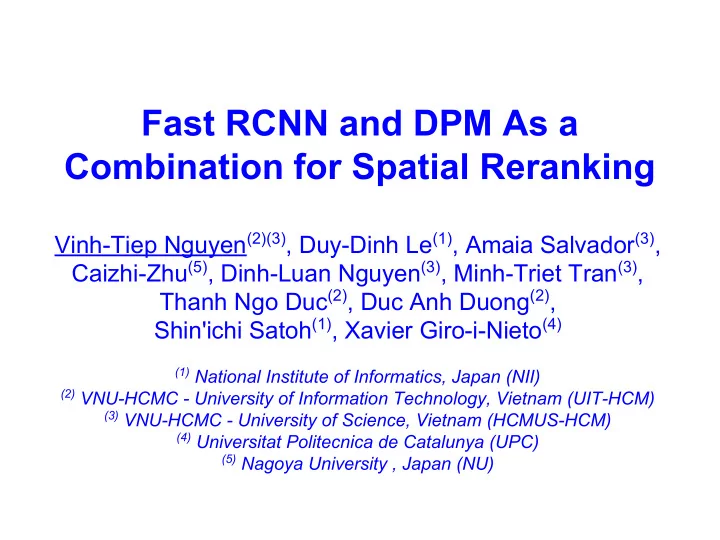

Fast RCNN and DPM As a Combination for Spatial Reranking Vinh-Tiep Nguyen (2)(3) , Duy-Dinh Le (1) , Amaia Salvador (3) , Caizhi-Zhu (5) , Dinh-Luan Nguyen (3) , Minh-Triet Tran (3) , Thanh Ngo Duc (2) , Duc Anh Duong (2) , Shin'ichi Satoh (1) , Xavier Giro-i-Nieto (4) (1) National Institute of Informatics, Japan (NII) (2) VNU-HCMC - University of Information Technology, Vietnam (UIT-HCM) (3) VNU-HCMC - University of Science, Vietnam (HCMUS-HCM) (4) Universitat Politecnica de Catalunya (UPC) (5) Nagoya University , Japan (NU)
General Instance Search Framework (1) (2) (1) Three things everyone should know to improve object retrieval, R. Arandjelović, A. Zisserman, CVPR 2012 (2) Query-adaptive asymmetrical dissimilarities for visual object retrieval, Cai- Zhi Zhu, Hervé Jégou, Shin'Ichi Satoh, ICCV 2013.
Last Year (2014) Method BOW are used to quickly filter out unrelated frames/shots Retrieve Top K Remove Outlier Shots Using Shared Words BOW Model Using RANSAC Query images Our main Top K Shots contribution last year system Compute DPM Build DPM Compute Score and Model New Score Bounding Box DPM Model Sort Scores DPM with denser feature (HOG) improves the Final Ranked List performance in case of less featured object
BOW is Good for Rich Featured Objects
But … Not for Less Textured Objects ● Small objects Query
Background Dominated Query Object ● Burstiness Query
DPM-based Object Localizer Visualization of DPM model for query 9109 Query 9109 ● Benefit: ○ Model query object as a shape structure. ○ Work well with small and texture-less object. ○ Augment bounding box information.
DPM Is Good for Less Textured Objects Wrong shared words case No shared word case
DPM: The Good and The Bad ● DPM is based on gray scale feature
Re-Scoring Method → Our Main Contribution in 2014
However ● How to weight score of BOW and DPM? ● How to handle more highly deformable and rich colored texture objects? ⇒ This year, we tried two methods.
Query Adaptive Fusion ● Instead of using average approach (w1=w2), we proposed an adaptive way of fusion. ● A neural network is used to automatically estimate weights of combining the two scores of BOW and DPM.
Query Adaptive Fusion ● Input of the network are features derived from: ○ average ratio of object area to image area ○ average number of keypoints inside query mask ○ number of shared visual words between two query examples ● Output of the network is weight of BOW and DPM derived from last years dataset ● Adaptive fusion score ( NII_HITACHI_UIT_1 ):
Combination with RCNN Based Object Detector ● DPM are good, but it: ○ does not take into account color information ○ has not enough training data and hard negatives ○ still bad at too much deformable object (with occlusion) ● RCNN based object detector are current SOA ○ uses color information to compute similarity score ○ trained on a lot of data ○ retrained on specific query object ○ still not good at finding bounding box ⇒ We combine these methods together
Final Score Based on Fast RCNN and DPM ● The final score of our proposed method is given as following ( NII_HITACHI_UIT_3 ): where, ○ Bounding box is kept as last year (returned from DPM), 3 types of shared points are computed the same ○ Normalized score of Fast RCNN are used to compute base score
Experiments
Results - Good ● We got max perf on 8/30 queries from our 4 submitted runs. ● Object query (9145 → this jukebox wall unit) ● Object query (9146 → this change machine)
Results - Good ● Consistently good for logo query (2014 & 2015) ● (9137 → a Ford script logo )
Results - Bad ● Small objects (9129 → this silver necklace)
Results - Bad ● Texture, illumination (9139 → this shaggy dog (Genghis))
Results - Bad ● Color information is important (9136 → this yellow VW beetle with roofrack)
Results - Bad ● Context (9155 → this dart board)
Conclusions ● The first time we use a RCNN in our system and it improves pretty much compared to two baselines (41.76% → 42.42%) ○ take into account pretrained network. ○ take advantage of color information. ● We tried to improve the adaptive weighting and it works on previous datasets, but unsuccessful in this year (40.11% vs 41.76%) ● There still have unsolved problems: ○ Too small objects (with no texture). ○ Too flexible query instances: persons, animals.
Best Run NII_Hitachi_UIT_3 (42.42%) necklace dart board shaggy dog textual feature (e.g keywords) is the key
Recommend
More recommend